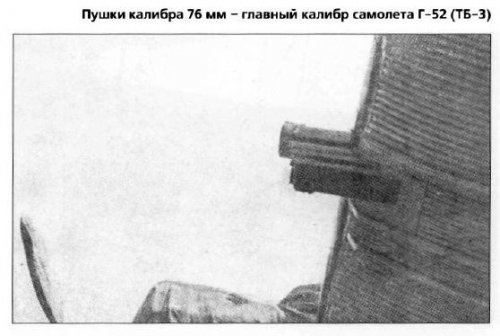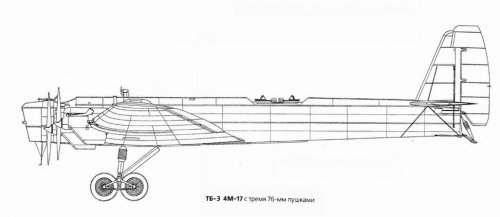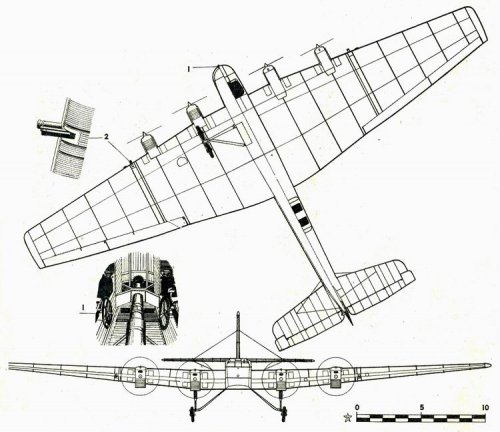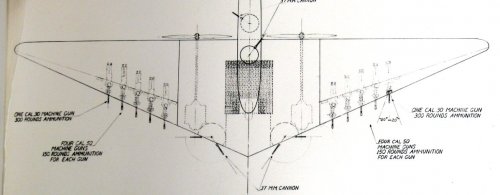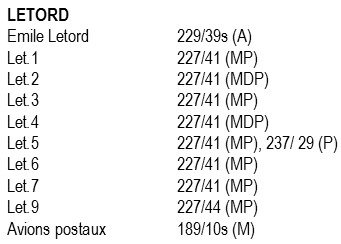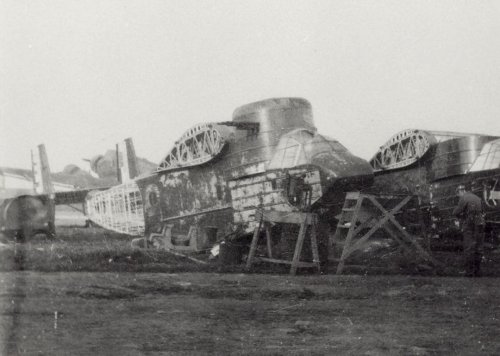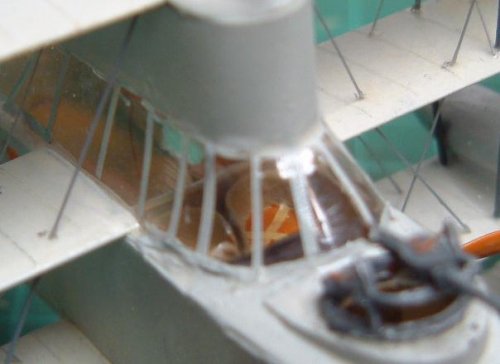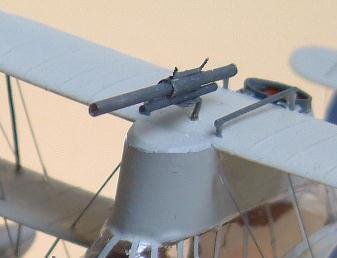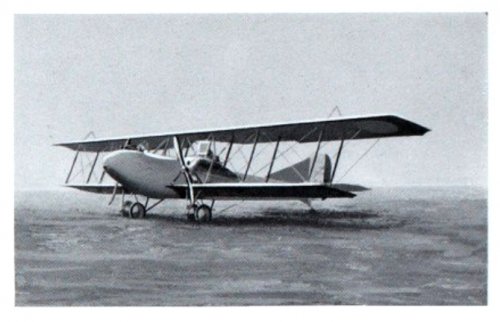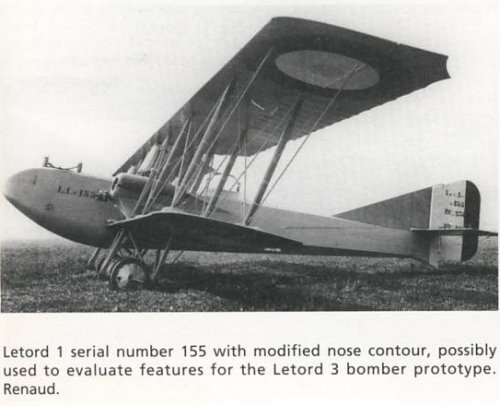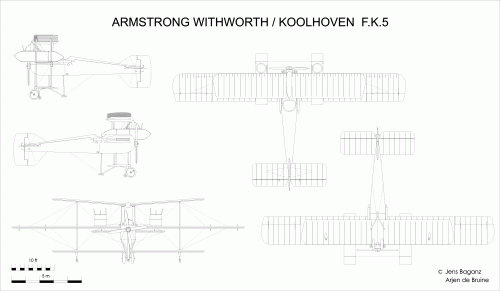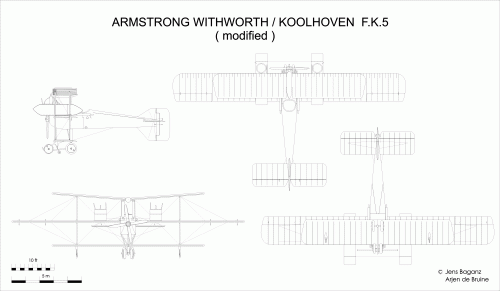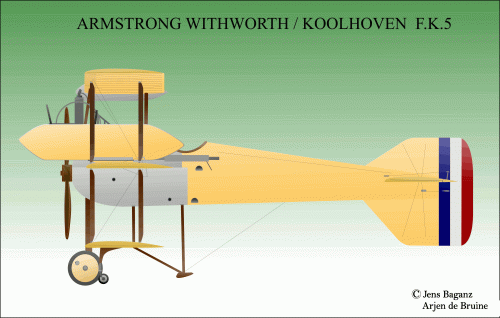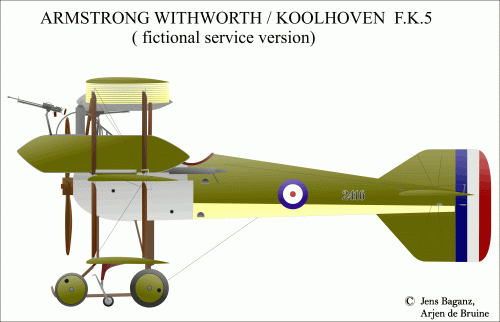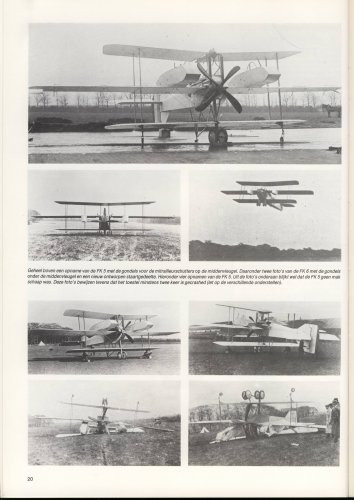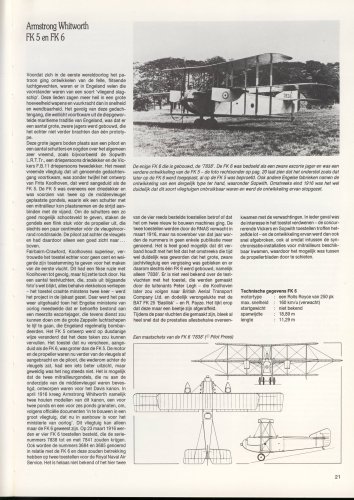You are using an out of date browser. It may not display this or other websites correctly.
You should upgrade or use an alternative browser.
You should upgrade or use an alternative browser.
Multi-seat fighters: "cruiser fighters" and "battleplanes"
- Thread starter Avimimus
- Start date
it's true , we have missed it !JohnR said:
Boogey
B'Boomelang
- Joined
- 10 February 2009
- Messages
- 200
- Reaction score
- 41
Well, by the way it's the Grigorovich LK-3 to my collection.redstar72 said:Анатолий, большое спасибо! Thank you very much Anatoly!
The DG-56 is a very elegant aircraft. Unarmed it looks like long-range racer.
Thanks, Анатолий
Avimimus
ACCESS: Top Secret
- Joined
- 15 December 2007
- Messages
- 2,427
- Reaction score
- 909
Added:
Does anyone have more information on the Grokhovskiy G-52 "Heavy Cruiser" derivative of the TB-3? I'm curious as to how the 76mm were supposed to be employed. Were they fixed forward firing or mobile? Were they intended for purely air-to-air use or where they dual purpose?
Thanks,
hesham said:Very nice work my dear Borovik,
and also the Bolkhovitinov TK-1 was a heavy cruise aircraft projects,
developed from DB-2,and it had crew of 11 and 3 ShVAK (3,000 rounds),
5 ShKAS (11,000 rounds) and underwing rockets.
Does anyone have more information on the Grokhovskiy G-52 "Heavy Cruiser" derivative of the TB-3? I'm curious as to how the 76mm were supposed to be employed. Were they fixed forward firing or mobile? Were they intended for purely air-to-air use or where they dual purpose?
Thanks,
G-52 - Grokhovskiy's was a serial TB-3 aircraft powered by the M-17, which in the nose fuselage was installed anti-aircraft gun, 76 mm sample in 1931, and in the wings - two 76-mm field gun model 1927
Guns revived manually. (12 shells on each wing cannon / 20 shells from central) thickness of the wing allowed to remain in the artillery guns (sitting with his back to the wing leading edge).
It was assumed that the group "flying batteries" will be ahead of the bombers and clear the way for them from enemy fighters, balloons. Also, G-52 could be used as a "destroyer of order" enemy bombers. Having a large range, he could fire from outside the effective destruction of their weapons. Besides the large ground targets: airfields, bridges, junctions, etc.
There was another project by Grokhovskiy, he also uses the constructive nodes TB-3, but with a NEW, much narrower fuselage, in which there is no unnecessary bomb bay. Wing guns sought to make mobile (suspended), to supply the artillery range finders and sights ...
sources: 'Kryl'a Rodiny' #7,1992
V.Kotelnikov-"Flying artillery batteries"- Aircraft - giants of the USSR
Guns revived manually. (12 shells on each wing cannon / 20 shells from central) thickness of the wing allowed to remain in the artillery guns (sitting with his back to the wing leading edge).
It was assumed that the group "flying batteries" will be ahead of the bombers and clear the way for them from enemy fighters, balloons. Also, G-52 could be used as a "destroyer of order" enemy bombers. Having a large range, he could fire from outside the effective destruction of their weapons. Besides the large ground targets: airfields, bridges, junctions, etc.
There was another project by Grokhovskiy, he also uses the constructive nodes TB-3, but with a NEW, much narrower fuselage, in which there is no unnecessary bomb bay. Wing guns sought to make mobile (suspended), to supply the artillery range finders and sights ...
sources: 'Kryl'a Rodiny' #7,1992
V.Kotelnikov-"Flying artillery batteries"- Aircraft - giants of the USSR
Attachments
Steve Pace
Aviation History Writer
- Joined
- 6 January 2013
- Messages
- 2,266
- Reaction score
- 225
Source?Orionblamblam said:Now *this* was a "battleplane..."
Avimimus said:Do you have a designation?
Yes. It's "Orionblamblam."
XB-70 Guy said:Source?
Aerospace Projects Review issue V2N6 or V3N1. Haven't decided yet.
amazing project ! B)Orionblamblam said:Avimimus said:Do you have a designation?
Yes. It's "Orionblamblam."
XB-70 Guy said:Source?
Aerospace Projects Review issue V2N6 or V3N1. Haven't decided yet.
Avimimus
ACCESS: Top Secret
- Joined
- 15 December 2007
- Messages
- 2,427
- Reaction score
- 909
I seem to remember a French proposal for large "flying fortress" type fighters. These aircraft would be considerably larger and better armed than the Caudron series.
It would have been right at the end of the Great War (service dates 1919-1920). However, I can't remember or find anything else.
Any ideas?
It would have been right at the end of the Great War (service dates 1919-1920). However, I can't remember or find anything else.
Any ideas?
Tophe
ACCESS: Top Secret
The Blériot 270 unbuilt project of 1931 was a French “croiseur aérien” (aerial cruiser).
Tophe
ACCESS: Top Secret
Pepe Rezende
ACCESS: Confidential
- Joined
- 3 May 2006
- Messages
- 101
- Reaction score
- 14
Avimimus
ACCESS: Top Secret
- Joined
- 15 December 2007
- Messages
- 2,427
- Reaction score
- 909
Very interesting finds!
About ten years later than my mysterious memory - but still excellent to have on the list.
It would be nice to have more information about some of these designations.
Tophe said:The Blériot 270 unbuilt project of 1931 was a French “croiseur aérien” (aerial cruiser).
About ten years later than my mysterious memory - but still excellent to have on the list.
It would be nice to have more information about some of these designations.
Tophe
ACCESS: Top Secret
The source was the old huge book about Blériot aircraft (Maeght publisher, 1994). It has now been printed again, updated and supplemented with SPAD aircraft, in the Docavia collection. If someone has this new printing, he/she could tell us if the date 1931 is confirmed or corrected for the Blériot 270.
igor-mich said:Dear Borovik not tell when the book is scheduled for release on Maslow Grigorovich
The book is laid/page-proof out a year ago.
Problems have arisen at the publishing house which was the primary arrangement. The search for potential publishers continue ...
Chapters of the book is already possible to read in the current issue of a magazine "Wings," #7 p.86-93
Подробней в личке
- Joined
- 5 May 2007
- Messages
- 351
- Reaction score
- 409
Additional photos of the one-off Consolidated XB-41 Liberator (ex- B-24D, USAAF 41-11822) bomber escort version of the B-24 Liberator posted by the San Diego Air & Space Museum Archives (SDASM)at Flickr:
http://www.flickr.com/photos/sdasmarchives/tags/xb41/
The SDASM has recently started posting higher resolution images of their archive photos, unfortunately this run of XB-41 was posted in 2010 when purposely lower resolution images were placed on their Flickr page.
Nonetheless, here are couple of examples of the XB-41 photos:


http://www.flickr.com/photos/sdasmarchives/tags/xb41/
The SDASM has recently started posting higher resolution images of their archive photos, unfortunately this run of XB-41 was posted in 2010 when purposely lower resolution images were placed on their Flickr page.
Nonetheless, here are couple of examples of the XB-41 photos:
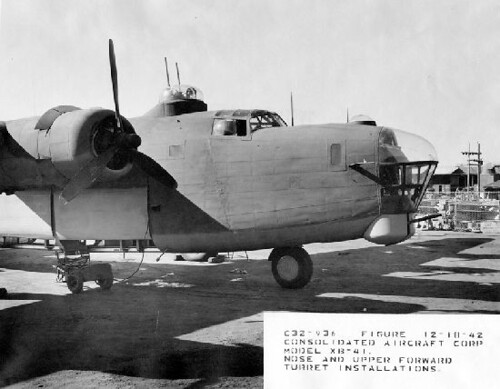
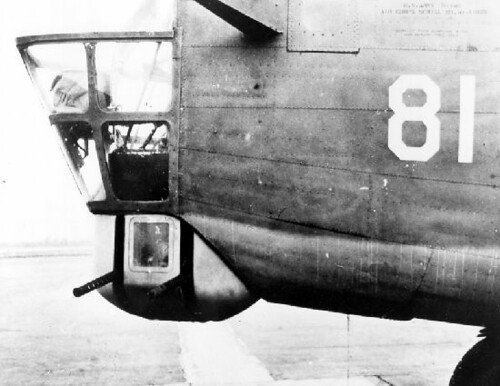
pathology_doc
ACCESS: Top Secret
- Joined
- 6 June 2008
- Messages
- 1,587
- Reaction score
- 1,510
Wouldn't the rotating turret with multi-position sighting and firing capability of the P-61 put it at least close to this category?
- Joined
- 11 March 2006
- Messages
- 8,625
- Reaction score
- 3,806
Avimimus said:I recently found a reference to bizarre WWI fighter proposals built around the Davis Recoilless Rifle.
Wasn't the Pemberton Billing PB.31 (you mentioned it in post #1) armed with a Davis gun ?
- Joined
- 26 May 2006
- Messages
- 34,916
- Reaction score
- 15,790
Stargazer2006 said:Picture of a French Letord battleplane:
Hi Stargazer,
you must ID this Letord design,this company created a series of aircraft,began with
Letord 1 up to 9,all are well known aircraft,except Letord 8 ?.
- Joined
- 25 June 2009
- Messages
- 14,754
- Reaction score
- 6,155
hesham said:you must ID this Letord design,this company created a series of aircraft,began with
Letord 1 up to 9,all are well known aircraft,except Letord 8 ?.
I'm really sorry hesham but I know very little about first World War aircraft, so I was hoping that perhaps someone would identify it...
- Joined
- 26 May 2006
- Messages
- 34,916
- Reaction score
- 15,790
Stargazer2006 said:hesham said:you must ID this Letord design,this company created a series of aircraft,began with
Letord 1 up to 9,all are well known aircraft,except Letord 8 ?.
I'm really sorry hesham but I know very little about first World War aircraft, so I was hoping that perhaps someone would identify it...
Never mind my friend,
but may be this aircraft was Let.6,which was an escort fighter,considered the only
Letord design to be a fighter.
- Joined
- 6 November 2010
- Messages
- 5,263
- Reaction score
- 5,517
Stargazer2006 said:Picture of a French Letord battleplane:

From Davilla & Soltan's magnificent, worth-robbing-a-bank-for 'French Aircraft of the First World War':
Attachments
Avimimus
ACCESS: Top Secret
- Joined
- 15 December 2007
- Messages
- 2,427
- Reaction score
- 909
hesham said:but may be this aircraft was Let.6,which was an escort fighter,considered the only
Letord design to be a fighter.
However, I believe I'm correct when I say that the A3 requirement was very much viewed as 'multipurpose'. The boundaries between different types of aircraft were vaguer in WWI.
The similar three-seat Caudron R.4 apparently was quite effective in air combat "Escadrille C.46 claimed 34 German aircraft brought down with its R.4s in an eight-week period" and the R.11 and R.14 were used for escort.
However, my favourite aircraft designed to this requirement was the Salmson Moineau S.M.1:


- Joined
- 11 March 2006
- Messages
- 8,625
- Reaction score
- 3,806
Interesting engine installation ! Mounting radials in the fuselage wasn't tried too
often, I think. The only other example, that comes to my mind is the Morane Saulnier
TRK (http://www.secretprojects.co.uk/forum/index.php/topic,17792.msg169735.html#msg169735).
Maybe cooling problems ? Vibrations of the shafts ?
often, I think. The only other example, that comes to my mind is the Morane Saulnier
TRK (http://www.secretprojects.co.uk/forum/index.php/topic,17792.msg169735.html#msg169735).
Maybe cooling problems ? Vibrations of the shafts ?
Avimimus
ACCESS: Top Secret
- Joined
- 15 December 2007
- Messages
- 2,427
- Reaction score
- 909
I believe that the primary issue in this case was increased maintenance (although vibrations may also have been an issue). More importantly, mechanical losses cancelled out much of the advantage given by the more complex arrangment. However, it seems to have performed as well as the other A3 aircraft on slightly less engine power. Information is hard to come by, but it appears that 155 may have been produced, some with 37mm cannons replacing the machine guns.
The design becomes even more interesting when you realise that there is only one engine: The shaft extends forward and backward to drive both propellers!
The design becomes even more interesting when you realise that there is only one engine: The shaft extends forward and backward to drive both propellers!
- Joined
- 6 November 2010
- Messages
- 5,263
- Reaction score
- 5,517
The Armstrong Whitworth FK 5, as reconstructed by Jemiba, with some help from me. Jens did all the heavy lifting. Source material from the Wesselink/Postma book.
Translation of 'Armstrong Whitworth FK 5 en FK 6' from 'Koolhoven - Nederlands vliegtuigbouwer in de schaduw van Fokker' by Theo Wesselink and Thijs Postma, Unieboek, 1981:
Translation of 'Armstrong Whitworth FK 5 en FK 6' from 'Koolhoven - Nederlands vliegtuigbouwer in de schaduw van Fokker' by Theo Wesselink and Thijs Postma, Unieboek, 1981:
Presenting the material took a little longer because of my intervening expedition to see two Lancasters in formation over Duxford.Armstrong Whitworth
FK 5 and FK 6
During World War One, before the pattern of fast, furious aerial dogfights developed, many in England were proponents of a kind of 'flying battleship'. These people saw more merit in great number of weapons and firepower than speed and maneuverability. The result of this train of thought, which may have come from England's deep-rooted maritime tradition, was a number of big, heavy fighters being built, which did not advance to more than one prototype each.
These big fighters offered room for a pilot and a number of gunners and generally appeared very strange, like, for instance, the Sopwith L.R.T.Tr three-seat triplane and Vickers F.B.11 three-seat biplane. Without a doubt, the strangest aircraft to emerge from the previously mentioned train of thought was Frits Koolhoven's FK 5 design. The FK 5 was a triplane too, and it featured two middle-wing mounted gondolas, in each of which a gunner could accomodate himself with a machine-gun to do battle with the enemy. To provide the gunners with an optimal field of fire, the gondolas protruded a good length ahead of the propellor, which turned mere centimetres away from the wing's leading edge. The pilot sat behind the wings, because of which he only had a good view... upward.
However, Fairbairn-Crawford, Koolhoven's superior, did not trust the craft one bit and refused to give permission for the first flight. A serious row ensued with Koolhoven, but he pressed on anyway. After some test flights, which, as shown in the accompanying photos, went anything but smoothly - the craft crashed at least two times - the project was put on hold. It was only resumed when the English ministry of war communicated its desire for a multiplace escort fighter, which could also serve to tackle the Zeppelin airships that regularly bombarded England. The FK 5 design was altered in such manner so it could perform these tasks. The aircraft that now emerged, designated FK 6, was bigger than the FK 5. The engine and propellor were positioned further away from the wings; the pilot, again seated behind the wings, had a slightly better view - but stellar it still was not. It is possible the two machine-gun gondolas, now mounted below the middle wing, were designed for the Davis gun. Armstrong Whitworth had in fact, in April 1916, received two wooden models of this gun, one for 2 pounds shells, one for 6 pounds shells, in order to, according to official documents, 'equip a large aeroplane, now building for the ministry of war'. This aeroplane can only have been the FK 6. The 23rd of March, 1916, four FK 6 aircraft were ordered, which were to receive serial numbers 7838 through 7841. The numbers 3684 and 3685 were also mentioned in connection with the FK 6, these were to apply to two aircraft for the Royal Naval Air Service. Unfortunately, it is not known whether this concerned two of the four aircraft already ordered, or two additional aircraft. The two aircraft were expected by the RNAS in March 1916, but after November of that year the numbers are no longer mentioned in any publication. It is well possible this is connected to the fact that, around that time, it had become clear that the big, heavy fighter had shown itself to be a mistake and therefore only one FK 6 had been built, the '7838'. Not much is known about the aircraft's test flights, conducted by Lieutenants Peter Legh - who would follow Koolhoven to British Aerial Transport Ltd. and fatally crashed the BAT FK 25 'Basilisk' - and R. Payze. It appears the tests were conducted in slapdash fashion.
During the few flights made, it became readily apparent performance anything but met expectations. Interest in the aircraft had evaporated anyway - the competing Vickers and Sopwith aircraft met the same fate - and development was soon abandoned, which also had to do with the new availability of synchronising gear for machine-guns, which enabled shooting through the propellor-disk.
Technical data FK 6
engine type: 250hp Rolls-Royce
max. speed: 160 km/h (estimated)
take-off weight: unknown
span: 18.90m
length: 11.29m
Attachments
Similar threads
-
Late 1930s and/or WWII fighter flying boats?
- Started by cluttonfred
- Replies: 53
-
Ricci Bros Projects: between the aerial motorcycle and the flying transatlantic
- Started by ermeio
- Replies: 45
-
-
Goodyear-Zeppelin ZRS-Derived Passenger Airship (~1935)
- Started by Hlostoops
- Replies: 18
-
Renard Aircraft Designations (Belgium - including R.S.V. & Stampe et Renard)
- Started by Cy-27
- Replies: 19

